tire size LEXUS NX300h 2021 User Guide
[x] Cancel search | Manufacturer: LEXUS, Model Year: 2021, Model line: NX300h, Model: LEXUS NX300h 2021Pages: 484, PDF Size: 10.53 MB
Page 358 of 484

3586-3. Do-it-yourself maintenance
LEXUS NX300h Owners Manual_USA_M78578_en
roads or icy roads, the use of snow tires is
recommended. When installing snow
tires, be sure to replace all four tires.
âAll season tires
All season tires are designed to provide
better traction in snow and to be ade-
quate for driving in most winter condi-
tions as well as for use year-round. All
season tires, however, do not have ade-
quate traction performance compared
with snow tires in heavy or loose snow.
Also, all season tires fall short in accelera-
tion and handling performance com-
pared with summer tires in highway
driving.
âSnow tires
For driving on snow-covered roads or icy
roads, we recommend using snow tires. If
you need snow tires,
select tires of the
same size, construction and load capacity
as the originally insta lled tires. Since your
vehicle has radial tires as original equip-
ment, make sure your snow tires also
have radial construction. Do not install
studded tires without first checking local
regulations for possible restrictions.
Snow tires should be installed on all
wheels. ( ï®P.279)
â If the tread on snow tires wears down
below 0.16 in. (4 mm)
The effectiveness of the tires as snow tires is
lost.
Rotate the tires in the order shown.
To equalize tire wear and extend tire life,
Lexus recommends that tire rotation is car-
ried out at the same in terval as tire inspec-
tion.
Do not fail to initialize the tire pressure
warning system after tire rotation.
WARNING
â When inspecting or replacing tires
Observe the following precautions to
prevent accidents.
Failure to do so may cause damage to
parts of the drive train as well as danger-
ous handling characteristics, which may
lead to an accident resulting in death or
serious injury.
âDo not mix tires of different makes,
models or tread patterns.
Also, do not mix tires of remarkably
different treadwear.
âDo not use tire sizes other than those
recommended by Lexus.
âDo not mix differently constructed
tires (radial, bias-belted or bias-ply
tires).
âDo not mix summer, all season and
snow tires.
âDo not use tires that have been used
on another vehicle.
Do not use tires if you do not know
how they were used previously.
âDo not tow if your vehicle has a com-
pact spare tire installed.
NOTICE
â Driving on rough roads
Take particular care when driving on
roads with loose surfaces or potholes.
These conditions may cause losses in tire
inflation pressure, reducing the cushion-
ing ability of the tires. In addition, driving
on rough roads may cause damage to
the tires themselves, as well as the vehi-
cleâs wheels and body.
â If tire inflation pressure of each tire
becomes low while driving
Do not continue driving, or your tires
and/or wheels may be ruined.
Tire rotation
Page 359 of 484

3596-3. Do-it-yourself maintenance
LEXUS NX300h Owners Manual_USA_M78578_en
6
Maintenance and care
Front
Your vehicle is equipped with a tire
pressure warning system that uses tire
pressure warning valves and transmit-
ters to detect low tire inflation pressure
before serious problems arise.
ï¬ If the tire pressure drops below a
predetermined level, the driver is
warned by a warning light.
(ï® P.394)
ï¬ The tire pressure detected by the
tire pressure warning system can be
displayed on the multi-information
display.
â Routine tire inflation pressure checks
The tire pressure warning system does not
replace routine tire inflation pressure
checks. Make sure to check tire inflation
pressure as part of your routine of daily vehicle checks.
â Situations in which the tire pressure
warning system may not operate prop-
erly
âIn the following cases, the tire pressure
warning system may not operate prop-
erly.
⢠If non-genuine Lexus wheels are used.
⢠A tire has been replaced with a tire that is not an OE (Original Equipment) tire.
⢠A tire has been replaced with a tire that is not of the specified size.
⢠Tire chains etc. are equipped.
⢠An auxiliary-supported run-flat tire is equipped.
⢠If a window tint that affects the radio wave signals is installed.
⢠If there is a lot of snow or ice on the vehi-
cle, particularly around the wheels or
wheel housings.
⢠If the tire inflation pressure is extremely
higher than the specified level.
⢠If wheel without the tire pressure warning valve and transmitter is used.
⢠If the ID code on the tire pressure warn- ing valves and transmitters is not regis-
tered in the tire pressure warning
computer.
âPerformance may be af fected in the fol-
lowing situations.
⢠Near a TV tower, electric power plant, gas station, radio stat ion, large display,
airport or other fac ility that generates
strong radio waves or electrical noise
⢠When carrying a portable radio, cellular
phone, cordless phone or other wireless
communication device
âWhen the vehicle is parked, the time
taken for the warning to start or go off
could be extended.
âWhen tire inflation pr essure declines rap-
idly for example when a tire has burst, the
warning may not function.
Tire pressure warning system
A
Page 365 of 484

3656-3. Do-it-yourself maintenance
LEXUS NX300h Owners Manual_USA_M78578_en
6
Maintenance and care
The recommended cold tire inflation
pressure and tire size are displayed on
the tire and loading information label.
(ï® P.430)
Tire valve Tire pressure gauge
1 Remove the tire valve cap.
2 Press the tip of the tire pressure
gauge onto the tire valve.
3 Read the pressure using the gauge
gradations.
4 If the tire inflation pressure is not at
the recommended level, adjust the
pressure.
If you add too much air, press the
center of the valve to deflate.
5 After completing the tire inflation
pressure measurement and adjust-
ment, apply soapy water to the
valve and check for leakage.
6 Put the tire valve cap back on.
â Tire inflation pressure check interval
You should check tire inflation pressure
every two weeks, or at least once a month.
Do not forget to check the spare.
â Effects of incorrect tire inflation pres-
sure
Driving with incorrect ti re inflation pressure
may result in the following:
âReduced fuel economy
âReduced driving comfort and poor han-
dling
âReduced tire life due to wear
âReduced safety
âDamage to the drive train
If a tire needs frequent inflating, have it
checked by your Lexus dealer.
â Instructions for checking tire inflation
pressure
When checking tire inflation pressure,
observe the following:
âCheck only when the tires are cold.
If your vehicle has been parked for at
least 3 hours or has not been driven for
Tire inflation pressure
Checking the specified tire infla-
tion pressure
Inspection and adjustment pro-
cedure
A
B
Page 367 of 484
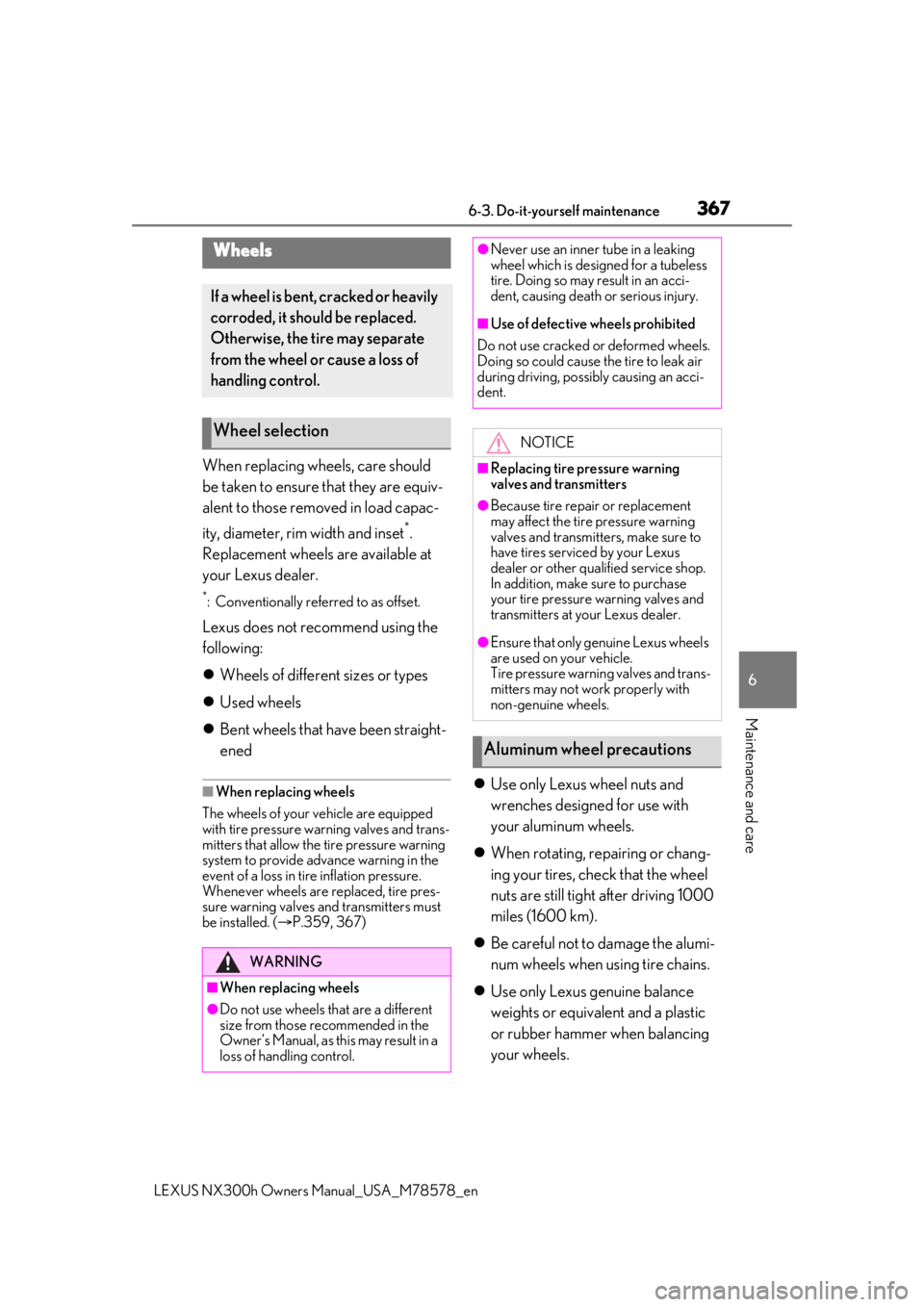
3676-3. Do-it-yourself maintenance
LEXUS NX300h Owners Manual_USA_M78578_en
6
Maintenance and care
When replacing wheels, care should
be taken to ensure that they are equiv-
alent to those removed in load capac-
ity, diameter, rim width and inset
*.
Replacement wheels are available at
your Lexus dealer.
*: Conventionally referred to as offset.
Lexus does not recommend using the
following:
ï¬ Wheels of different sizes or types
ï¬ Used wheels
ï¬ Bent wheels that have been straight-
ened
â When replacing wheels
The wheels of your vehicle are equipped
with tire pressure warning valves and trans-
mitters that allow the tire pressure warning
system to provide advance warning in the
event of a loss in tire inflation pressure.
Whenever wheels are replaced, tire pres-
sure warning valves an d transmitters must
be installed. ( ï®P.359, 367)ï¬ Use only Lexus wheel nuts and
wrenches designed for use with
your aluminum wheels.
ï¬ When rotating, repairing or chang-
ing your tires, check that the wheel
nuts are still tight after driving 1000
miles (1600 km).
ï¬ Be careful not to damage the alumi-
num wheels when using tire chains.
ï¬ Use only Lexus genuine balance
weights or equivalent and a plastic
or rubber hammer when balancing
your wheels.
Wheels
If a wheel is bent, cracked or heavily
corroded, it should be replaced.
Otherwise, the tire may separate
from the wheel or cause a loss of
handling control.
Wheel selection
WARNING
â When replacing wheels
âDo not use wheels that are a different
size from those recommended in the
Ownerâs Manual, as this may result in a
loss of handling control.
âNever use an inner tube in a leaking
wheel which is designed for a tubeless
tire. Doing so may result in an acci-
dent, causing death or serious injury.
â Use of defective wheels prohibited
Do not use cracked or deformed wheels.
Doing so could cause the tire to leak air
during driving, possibly causing an acci-
dent.
NOTICE
â Replacing tire pressure warning
valves and transmitters
âBecause tire repair or replacement
may affect the tire pressure warning
valves and transmitters, make sure to
have tires serviced by your Lexus
dealer or other qua lified service shop.
In addition, make sure to purchase
your tire pressure warning valves and
transmitters at your Lexus dealer.
âEnsure that only genuine Lexus wheels
are used on your vehicle.
Tire pressure warning valves and trans-
mitters may not work properly with
non-genuine wheels.
Aluminum wheel precautions
Page 397 of 484

3977-2. Steps to take in an emergency
LEXUS NX300h Owners Manual_USA_M78578_en
7
When trouble arises
âAvoid abrupt maneuvering and brak-
ing. If the vehicle tires deteriorate, you
could lose control of the steering
wheel or the brakes.
â If a blowout or sudden air leakage
should occur
The tire pressure warning system may
not activate immediately.
â Maintenance of the tires
Each tire, including the spare (if pro-
vided), should be checked monthly when
cold and inflated to the inflation pressure
recommended by the vehicle manufac-
turer on the vehicle placard or tire infla-
tion pressure label (tire and load
information label). (I f your vehicle has
tires of a different size than the size indi-
cated on the vehicle placard or tire infla-
tion pressure label [tire and load
information label], yo u should determine
the proper tire infl ation pressure for
those tires.)
As an added safety feature, your vehicle
has been equipped with a tire pressure
monitoring system (TPMS-tire pressure
warning system) that illuminates a low
tire pressure telltale (tire pressure warn-
ing light) when one or more of your tires
is significantly under-inflated. Accord-
ingly, when the low tire pressure telltale
(tire pressure warnin g light) illuminates,
you should stop and check your tires as
soon as possible, and inflate them to the
proper pressure. Driving on a signifi-
cantly under-inflated tire causes the tire
to overheat and can lead to tire failure.
Under-inflation also reduces fuel effi-
ciency and tire tread life, and may affect
the vehicleâs handling and stopping abil-
ity.
Please note that the TPMS (tire pressure
warning system) is not a substitute for
proper tire maintenance, and it is the
driverâs responsibility to maintain correct
tire pressure, even if under-inflation has
not reached the level to trigger illumina-
tion of the TPMS low tire pressure telltale
(tire pressure warning light).
Your vehicle has also been equipped with
a TPMS (tire pressure warning system)
malfunction indicator to indicate when
the system is not operating properly. The
TPMS (tire pressure warning system)
malfunction indicator is combined with
the low tire pressure telltale (tire pres-
sure warning light) . When the system
detects a malfunction, the telltale will
flash for approximately one minute and
then remain continuously illuminated.
This sequence will continue upon subse-
quent vehicle start-ups as long as the
malfunction exists. When the malfunction
indicator is illuminated, the system may
not be able to detect or signal low tire
pressure as intended.
TPMS (tire pressure warning system)
malfunctions may occur for a variety of
reasons, including the installation of
replacement or alternate tires or wheels
on the vehicle that prevent the TPMS
(tire pressure warning system) from func-
tioning properly. Always check the
TPMS (tire pressure warning system)
malfunction telltale after replacing one
or more tires or wheels on your vehicle to
ensure that the replacement or alternate
tires and wheels allow the TPMS (tire
pressure warning system) to continue to
function properly.
NOTICE
â To ensure the tire pressure warning
system operates properly
Do not install tires with different specifi-
cations or makers, as the tire pressure
warning system may not operate prop-
erly.
Page 430 of 484
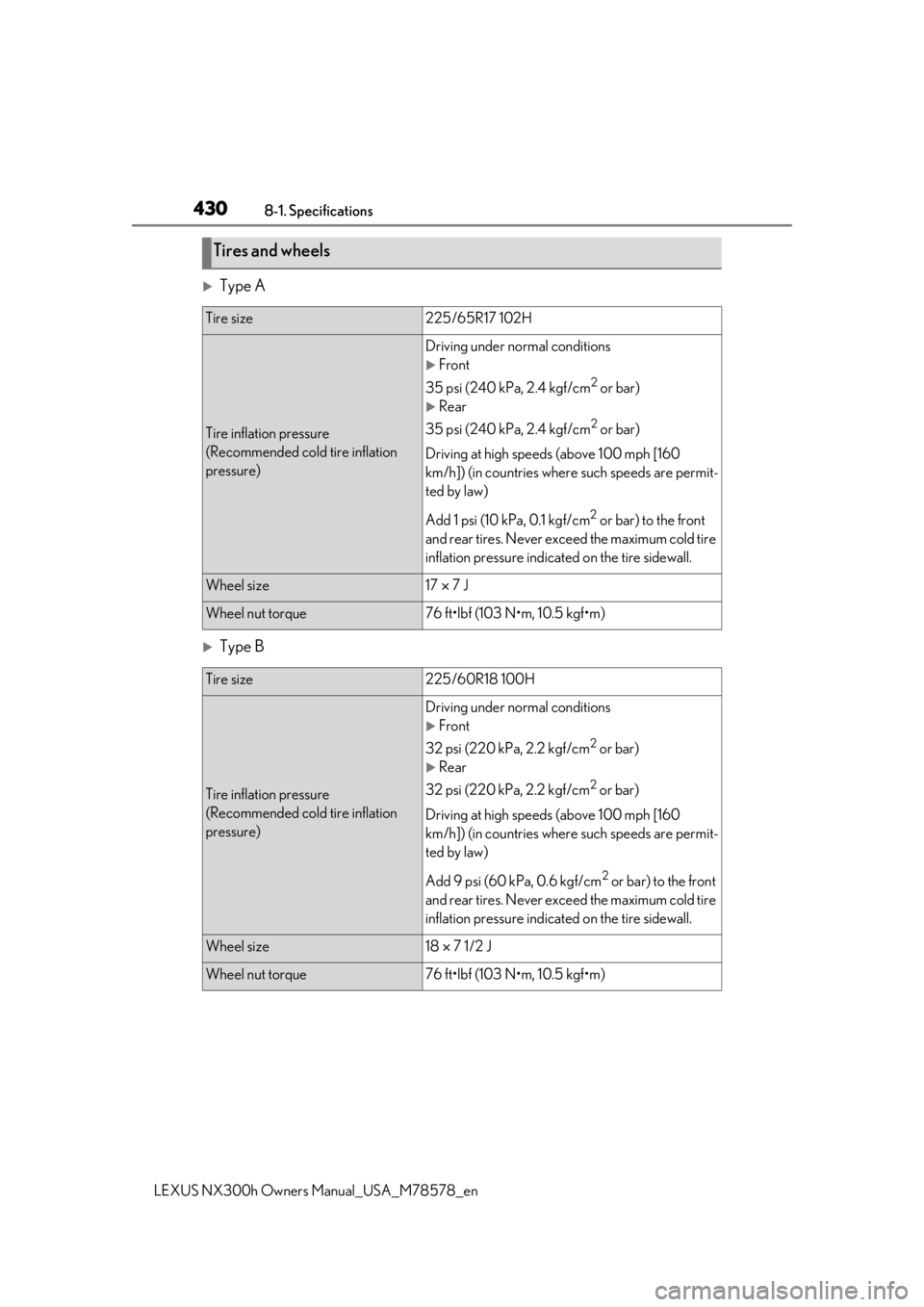
4308-1. Specifications
LEXUS NX300h Owners Manual_USA_M78578_en
ïµType A
ïµType B
Tires and wheels
Tire size225/65R17 102H
Tire inflation pressure
(Recommended cold tire inflation
pressure)
Driving under normal conditions
ïµFront
35 psi (240 kPa, 2.4 kgf/cm
2 or bar)
ïµRear
35 psi (240 kPa, 2.4 kgf/cm
2 or bar)
Driving at high speeds (above 100 mph [160
km/h]) (in countries where such speeds are permit-
ted by law)
Add 1 psi (10 kPa, 0.1 kgf/cm
2 or bar) to the front
and rear tires. Never exceed the maximum cold tire
inflation pressure indica ted on the tire sidewall.
Wheel size17 ï´ 7 J
Wheel nut torque76 ftâ¢lbf (103 Nâ¢m, 10.5 kgfâ¢m)
Tire size225/60R18 100H
Tire inflation pressure
(Recommended cold tire inflation
pressure)
Driving under normal conditions
ïµFront
32 psi (220 kPa, 2.2 kgf/cm
2 or bar)
ïµRear
32 psi (220 kPa, 2.2 kgf/cm
2 or bar)
Driving at high speeds (above 100 mph [160
km/h]) (in countries where such speeds are permit-
ted by law)
Add 9 psi (60 kPa, 0.6 kgf/cm
2 or bar) to the front
and rear tires. Never exceed the maximum cold tire
inflation pressure indica ted on the tire sidewall.
Wheel size18 ï´ 7 1/2 J
Wheel nut torque76 ftâ¢lbf (103 Nâ¢m, 10.5 kgfâ¢m)
Page 431 of 484
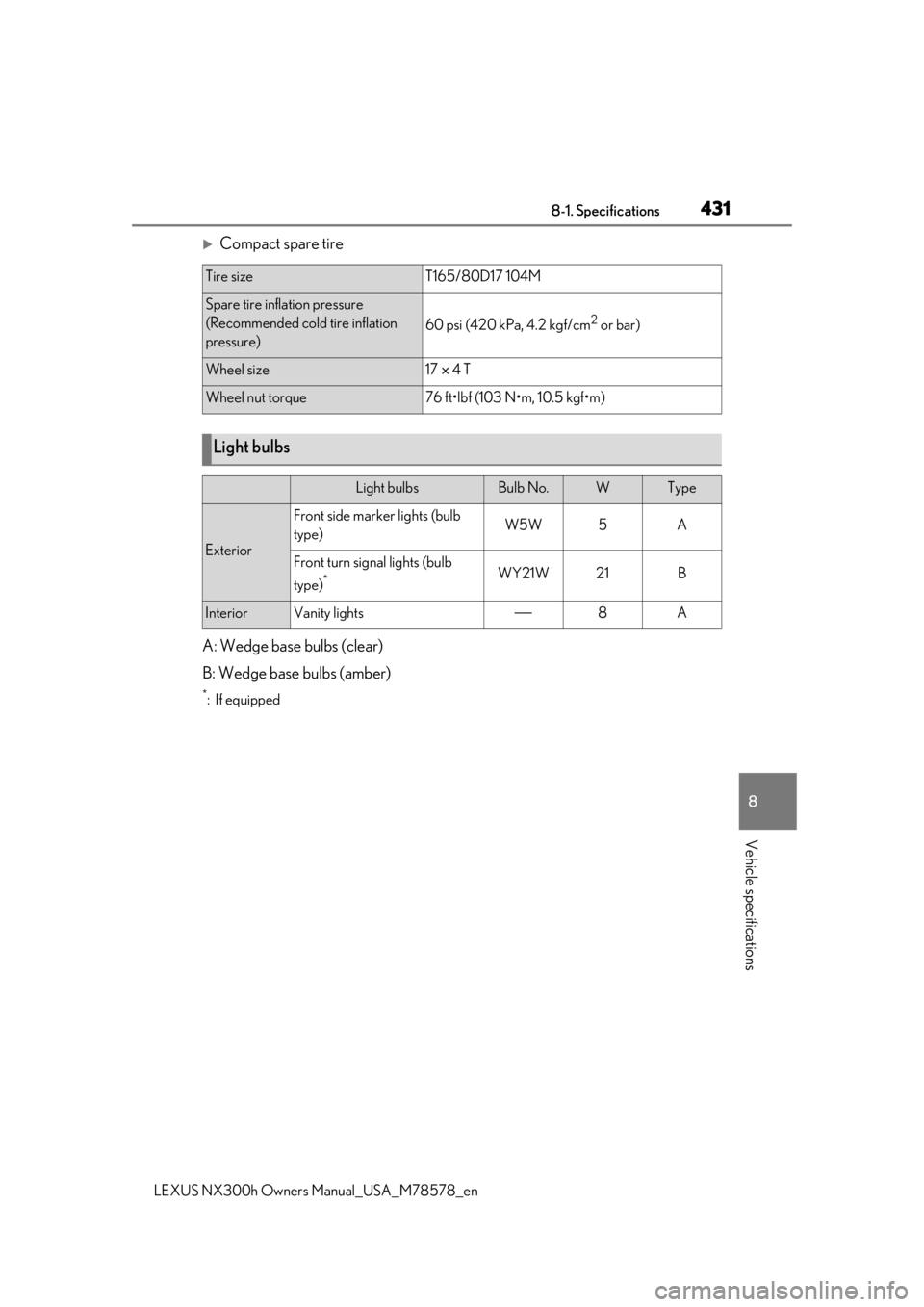
4318-1. Specifications
LEXUS NX300h Owners Manual_USA_M78578_en
8
Vehicle specifications
ïµCompact spare tire
A: Wedge base bulbs (clear)
B: Wedge base bulbs (amber)
*:If equipped
Tire sizeT165/80D17 104M
Spare tire inflation pressure
(Recommended cold tire inflation
pressure)
60 psi (420 kPa, 4.2 kgf/cm2 or bar)
Wheel size17 ï´ 4 T
Wheel nut torque76 ftâ¢lbf (103 Nâ¢m, 10.5 kgfâ¢m)
Light bulbs
Light bulbsBulb No.WType
Exterior
Front side marker lights (bulb
type)W5W5A
Front turn signal lights (bulb
type)
*WY21W21B
InteriorVanity lightsï¾8A
Page 434 of 484
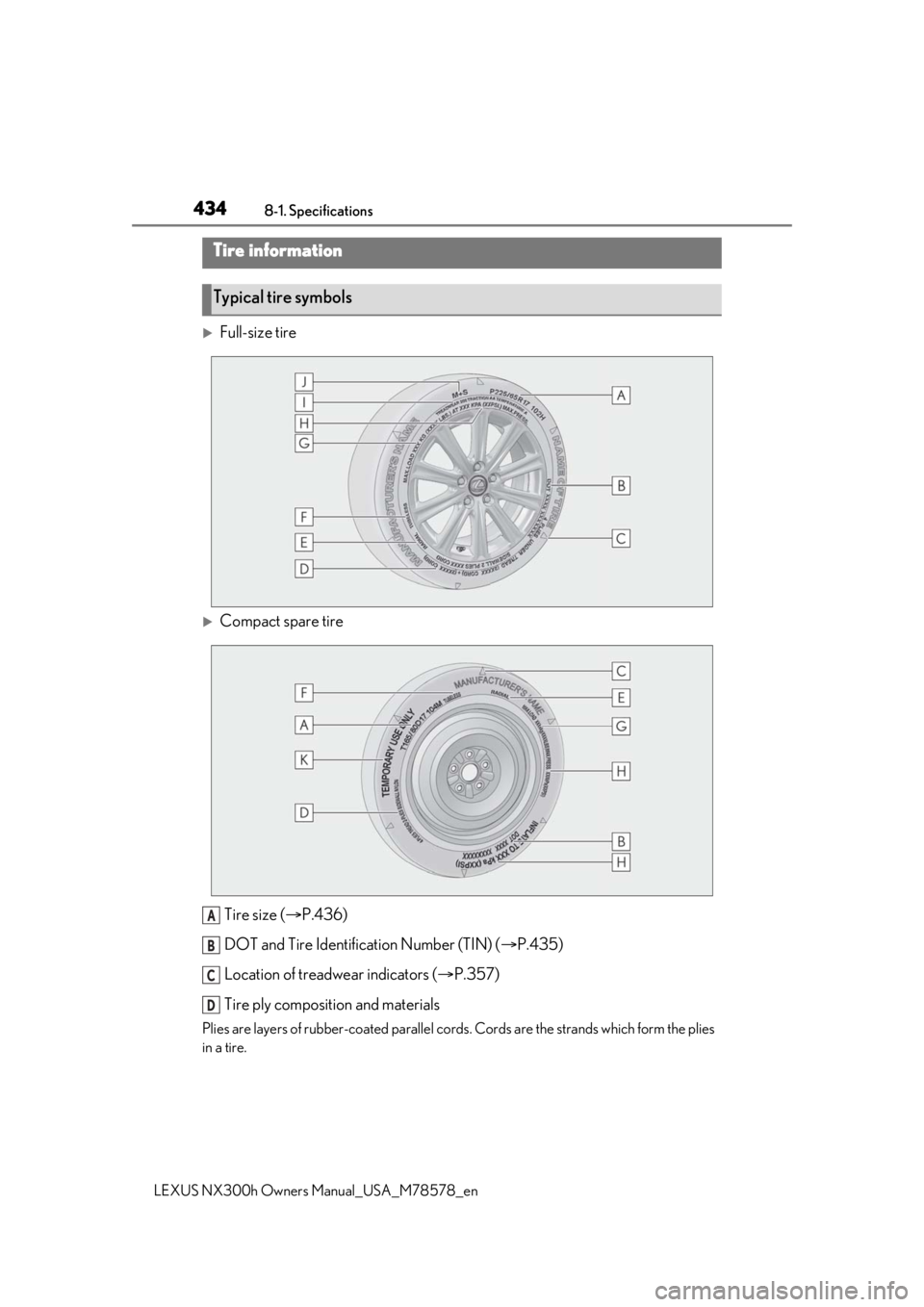
4348-1. Specifications
LEXUS NX300h Owners Manual_USA_M78578_en
ïµFull-size tire
ïµCompact spare tire
Tire size ( ï®P.436)
DOT and Tire Identification Number (TIN) ( ï®P.435)
Location of treadwear indicators (ï® P.357)
Tire ply composition and materials
Plies are layers of rubber-coated parallel cords. Cords are the strands which form the plies
in a tire.
Tire information
Typical tire symbols
A
B
C
D
Page 435 of 484
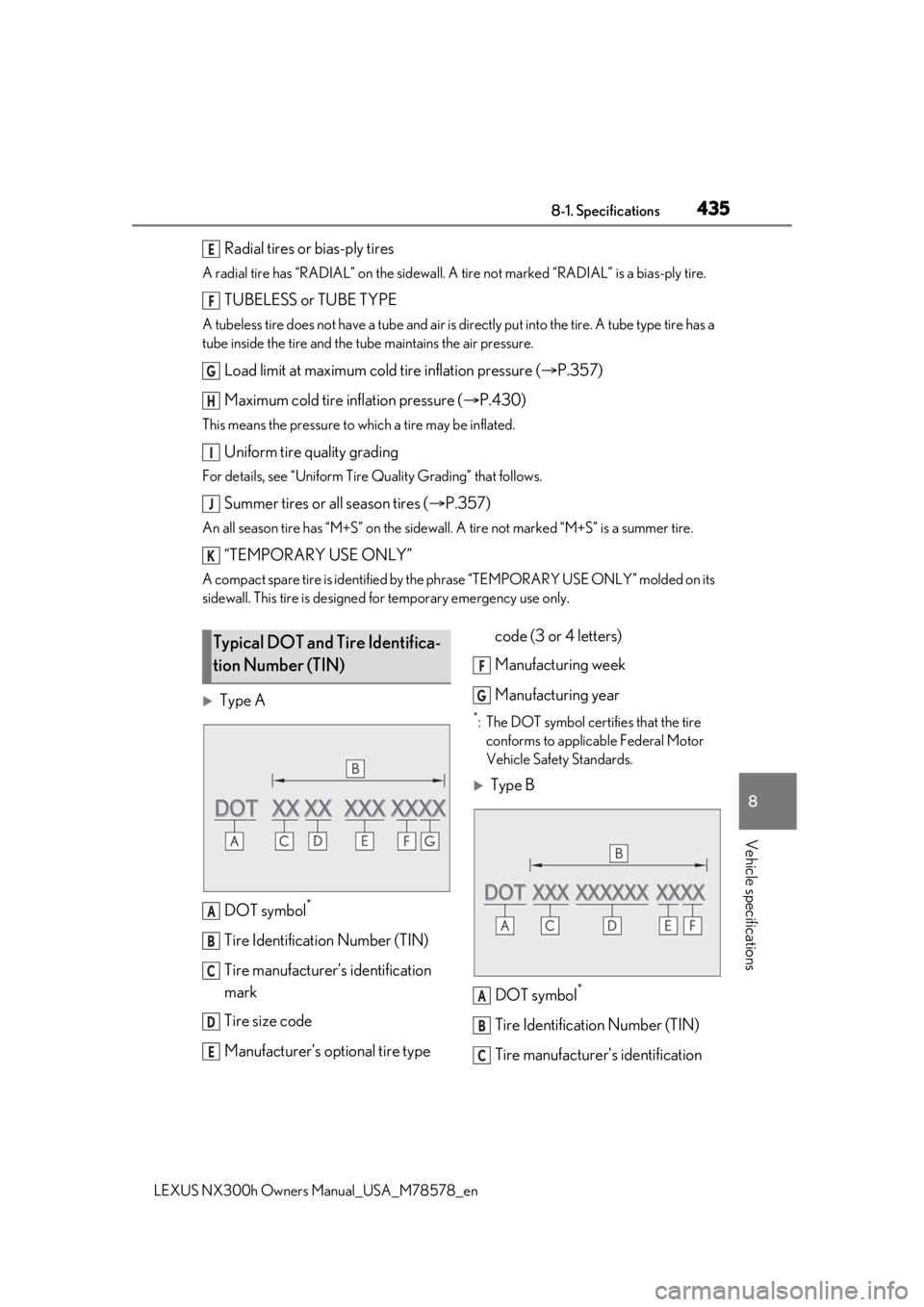
4358-1. Specifications
LEXUS NX300h Owners Manual_USA_M78578_en
8
Vehicle specifications
Radial tires or bias-ply tires
A radial tire has âRADIALâ on the sidewall. A tire not marked âRADIALâ is a bias-ply tire.
TUBELESS or TUBE TYPE
A tubeless tire does not have a tube and air is directly put into the tire. A tube type tire has a
tube inside the tire and the tube maintains the air pressure.
Load limit at maximum cold tire inflation pressure ( ï®P.357)
Maximum cold tire inflation pressure ( ï®P.430)
This means the pressure to which a tire may be inflated.
Uniform tire quality grading
For details, see âUniform Tire Quality Gradingâ that follows.
Summer tires or all season tires ( ï®P.357)
An all season tire has âM+Sâ on the sidewall. A tire not marked âM+Sâ is a summer tire.
âTEMPORARY USE ONLYâ
A compact spare tire is identified by the phrase âTEMPORARY USE ONLYâ molded on its
sidewall. This tire is designed for temporary emergency use only.
ïµType A
DOT symbol
*
Tire Identification Number (TIN)
Tire manufacturerâs identification
mark
Tire size code
Manufacturerâs optional tire type code (3 or 4 letters)
Manufacturing week
Manufacturing year
*: The DOT symbol certifies that the tire
conforms to applicable Federal Motor
Vehicle Safety Standards.
ïµType B
DOT symbol
*
Tire Identification Number (TIN)
Tire manufacturerâs identification
E
F
G
H
I
J
K
Typical DOT and Tire Identifica-
tion Number (TIN)
A
B
C
D
E
F
G
A
B
C
Page 436 of 484

4368-1. Specifications
LEXUS NX300h Owners Manual_USA_M78578_en
mark
Manufacturerâs code
Manufacturing week
Manufacturing year
*:The DOT symbol certifies that the tire
conforms to applicable Federal Motor
Vehicle Safety Standards.
â Typical tire size information
The illustration indicates typical tire
size.
Tire use
(P = Passenger car,
T = Temporary use)
Section width (millimeters)
Aspect ratio
(tire height to section width)
Tire construction code
(R = Radial, D = Diagonal)
Wheel diameter (inches)
Load index (2 digits or 3 digits)
Speed symbol (alphabet with one
letter)
â Tire dimensionsSection width
Tire height
Wheel diameter
Bead
Sidewall
Shoulder
Tread
Belt
Inner liner
Reinforcing rubber
Carcass
Rim lines
Bead wires
Tire size
D
E
F
A
B
C
D
E
F
G
Tire section names
A
B
C
A
B
C
D
E
F
G
H
I
J